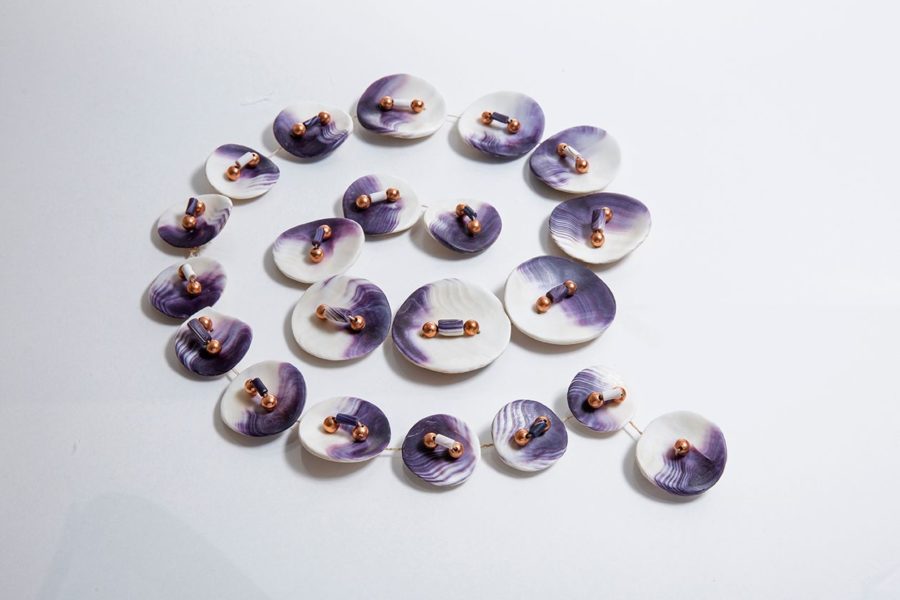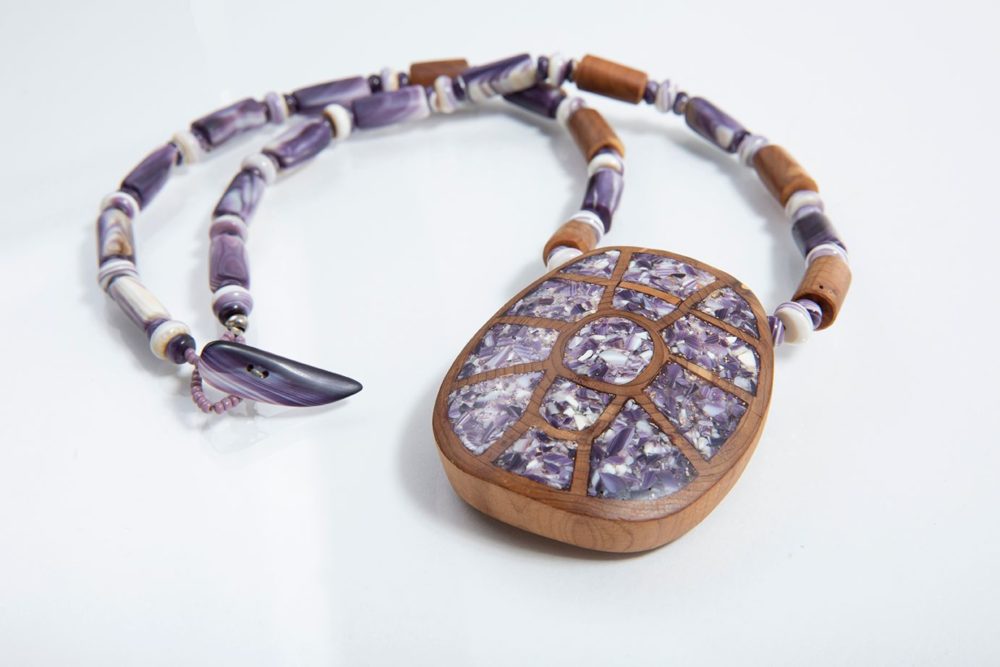Wampum Craft
The Power of a Purple Shell
By Sarah Schumann | Photographs by Marianne LeeWampum beads by Kristen Wyman
Wampum artisans Allen Hazard of the Narragansett Indian Tribe, Josh Carter of the Mashantucket Pequot Tribal Nation, Kristen Wyman of the Natick Nipmuc Tribe, and Annawon Weeden of the Mashpee Wampanoag Tribe are descended from the original peoples of the New England region and have spent years uncovering and expressing the beauty of the quahog shell.
The color purple in nature is prized for its beauty and rarity. Here in New England it is found buried in the murky depths of estuaries, further hidden in the cavity formed by the securely clamped shells of the Northern quahog (Mercenaria mercenaria).
Like the curl of purple inside a quahog’s shell, the history and contemporary culture of New England’s Native peoples often remain obscured from the mainstream view. In fact, one of the wampum makers profiled in this story recalls his schoolteacher sending him to detention as a child when he insisted that Native people existed at all in New England.
Through their work with wampum, these artisans illuminate their communities’ overlooked existence while invoking the craft’s traditional meaning—a meaning that artisan Josh Carter defines as “honoring those relationships with the shell and its life-giving properties from the ocean and then continuing to use the shell to exhibit relationship amongst other people.”
Origins of Wampum
The word “wampum,” or “wampumpeag,” derives from the Algonquian word for “white,” and originally, “wampum” referred to white beads hewn from the inner shells of whelks, not quahogs. Purple quahog shells, in turn, were called “suckauhock,” which incorporates the Algonquian word for “dark.” Over time, the words have become conflated, with “wampum” now generally referring to a variety of beads, adornments, and other crafts made from the shell of the quahog.
Historically, wampum was made by coastal tribes who had access to the shells, but it was culturally important for many Northeastern Woodlands nations, including those living hundreds of miles inland.

Kristen Wyman of the Natick Nipmuc Tribe created this belt in honor of her grandmother. Each disk represents one of her grandmother’s children and grandchildren. The disk with the single bead represents the community.
“We didn’t spell out words,” Annawon Weeden explains. “We didn’t have any form of an alphabet.” Instead, the white and purple beads were strung into woven belts, their contrasting colors forming patterns and pictures that communicated important information.
“My chief could wear our history,” Weeden says. “My medicine man could wear our history. A storyteller could bring the ‘bible’ out and explain each bead, how maybe hundreds of years ago, it was your great-great-great grandfather who actually made these beads over here. That was the original purpose of the wampum.”
Early wampum was made by hand, with pump drills or bow drills fitted with antler points or rigid thorns. The process was time-intensive. Ancient wampum artists used only the thickest part of each shell, where the purple is the darkest, and each shell typically produced a single bead.
“If you can imagine the time it takes to manufacture one bead,” Weeden reflects. “Those beads would be possibly saved for generations. I might need a couple of centuries of beads just to put together an ounce of that nature, depending on the size and the details in the belt.”
As a result, wampum was treasured. Carter explains, “The message would be spoken into that belt through a specific ceremony, prior to it being delivered to the receiver. Once that belt was delivered to its receiver, that same ceremony would be had, and it was believed that it would strengthen the message, strengthen the medicine.”
The purpose of wampum became misconstrued when Europeans arrived in North America. Seeing Native people offer each other wampum as a means of expressing gratitude, Europeans incorrectly concluded that wampum was a form of currency. Over time, explains Allen Hazard, wampum was adopted as a medium for exchange between settlers and Native Americans, as “we started to realize that money will get us things that just pulling things off of the land wouldn’t.”
However, the temporary use of wampum as a medium of exchange was a small part of a much larger, unbroken tradition of making and gifting wampum as an expression of reciprocity and connectedness. Most wampum makers consider the comparison to money to be demeaning.
Tradition to Today
Today, wampum available to the general public is most often in the form of decorative necklaces, earrings, and bracelets. Modern wampum makers use a variety of power tools, from tile saws to Dremel tools to diamond-tipped drill bits.
“There’s nothing wrong with adding the new with the old,” says Hazard. Early makers “weren’t able to use seven-strand cable. They weren’t able to use silver crimps. These are just little things that I know that you as a buyer might want my necklace to be made from.”
Another characteristic of modern-day wampum is its diversity. Early wampum makers prized uniformity, because beads crafted by multiple makers needed to be strung together on the same belts. Consistency of size and shape was achieved by threading beads onto a string and running the string through a groove in a designated stone. The same stone would be used by all wampum makers in the community, ensuring that all beads were the same size, regardless of whose hands made them.
Contemporary wampum making, in contrast, enables each maker to create a unique style all their own. All four wampum makers profiled here are able to differentiate among wampum pieces made by different artisans just by looking at them.
Carter compares these distinctive qualities to accents, “Like if you’re from Boston, and you got that slang. It has a little something to it that distinguishes something I would make versus something Allen would make. It’s something that I know most people aren’t going to recognize, but it’s something that stands out to me like a sore thumb.”
Wampum pipe by Allen Hazard of the Narragansett Indian Tribe, which he began as his daughter was diagnosed with cancer. He finished it the day he found she had gone into remission, and hopes to pass it down to her and succeeding generations of family.
Artist Allen Hazard continues to be driven by a desire to uphold “Narragansett tradition, the sacred reality of working with what the Creator placed on this earth for us to respect, the line that says, ‘This animal, this live being, has given its life so we can continue ours.’”
The Making of a Maker
Allen Hazard, the oldest of the four wampum makers profiled in this article, was exposed to wampum from a young age. “I saw my Uncle Harold and my Aunt Laura. I was just a nosy little stinker, and I knew what I liked. I would ask them questions. Then I would go off by myself. I was very confident that when I was done, it wasn’t going to be like what I saw; it was going to be better.”
At age 16, he made his first complete wampum piece: a macrame-braided necklace made of the prettiest shells he could find. He broke all the shells by hand using stones, and scraped them with another stone, rather than using power tools. “I was stubborn,” he recalls, saying that his attitude at the time was:
“I’m doing this the old-fashioned way.”
Although Hazard now uses modern tools to speed up the process, he continues to be driven by a desire to uphold “Narragansett tradition, the sacred reality of working with what the Creator placed on this earth for us to respect, the line that says, ‘This animal, this live being, has given its life so we can continue ours.’”
“That is what inspired me to think like my ancestors did,” Hazard adds, “and to take the artistry of it to a whole other level, in ways that they couldn’t, because of the tools that are available to me that were never available to them.”
Josh Carter didn’t start making wampum until he was in his 30s. Growing up, Carter recalled, “I didn’t believe I had one artistic bone in my body.” The desire to make wampum came to him suddenly during a moment of mourning.
“I lost a cousin who was a few years older than me,” Carter explains. “He was one of them larger-than-life humans. Rock solid. When somebody passes in our community, we have a passing fire. That fire stays lit until that person is put in the ground. It’s a healing process, a way to mourn and a way to share. I was at his fire, and it was very apparent to me. This whole idea of wampum was something that I was kind of drawn to. I just kind of felt like it always been in my heart. I promised myself I was going to try to be an artist.”
Carter reached out to someone he knew he could count on to teach him the essentials: Allen Hazard.
“I immediately sought Allen out, because he is ‘that guy.’ It’s just kind of common knowledge in our communities. He’s so giving and kind and patient. I will never be able to give back what he’s given me.”
Through wampum, Carter got to know himself in a new way. “For my personality and my personality traits, it’s just way outside of the box in terms of what I’m used to, this relationship with wampum. Just really connected. I look at the shell, and the shell tells me what’s going to come out of that shell. I feel like there’s not a lot of separation between me and what I end up with.”

Wampum pipe by Josh Carter of the Mashantucket Pequot Tribal Nation entitled, “Gift For My Grandchildren.” He and Hazard worked on this pipe together.
Wampum also deepened Carter’s connections with his ancestors. Making wampum, he said, “is a part of me that goes back thousands of years. It’s just amazing. It’s so humbling, and I’m so appreciative that the process is still alive. For some reason, the Creator chose to continue that through me. It’s like, ‘What, really?’ I don’t know if I deserve it, but I’ll take it.”
Kristen Wyman also apprenticed under Hazard for a year. “Prior to getting into wampum making, I did not consider myself a maker or an artist. My life purpose is to protect, defend, restore our food ways,” she says, which she does through her work with the nonprofit Why Hunger and as a grassroots organizer with the Eastern Woodlands Rematriation Collective.
She met Hazard at an art fair. Their chance meeting lingered in her mind, and a year later, she asked him if he would train her.
Reflecting on her apprenticeship experience, she says, “What’s beautiful about what happened is that I’m going to continue to carry on his way of making wampum. I haven’t taught anybody yet, but I imagine [teaching] maybe one of my daughters, or someone in the community. I know it’s a gift to know how to do this. I imagine, over time, I’ll find the right person that I’d say, ‘This is important to learn how to do and to continue.’”
Wyman’s community food systems work demands a lot of her time and energy, and wampum making is often pushed aside.
“The organizing work is very hard,” Wyman says. “There’s a lot of erasure and invisibility of indigenous people. It’s a pain that I live with every single day. In the work that I’m in, it’s me choosing to step into that every single day and face it head-on, knowing that I’m trying to change the situation. I get lost in that sometimes, and I just get depleted.”
Working with wampum, Wyman says, has been restorative. “Through that process, I realize how healing it is and what a privilege it is to be able to work with this material … It’s a gift for me. It’s not about me controlling the process or controlling the outcome or the shell. It’s about me humbling myself to that, and spending time, and being aware of all of the benefits and gifts and medicines that it gives.”
Annawon Weeden is a performer who practices song, dance, and traditional building demonstrations to promote knowledge of Native American culture in New England. Weeden laments that for the mainstream New Englander, Native culture is like a “scavenger hunt, hidden mystery, a treasure.” In his view, wampum is a way to make this culture more visible.
Although he made wampum casually for years, he decided to launch an online retail business, First Light Fashion, after observing the pervasiveness of Navajo turquoise jewelry throughout the Southwest.
“When I got out there, I noticed people were wearing the turquoise everywhere, even at the supermarket,” he recalls. “The arts are thriving everywhere. Young, old, boys, girls, you name it; everyone’s involved somehow in preserving the various arts of their community. It really showed me this is how Natives take pride, not just in [our] culture, but in our identity.”

That experience led to a revelation for Weeden. “I want to see that in wampum,” he says. “I may never see as many Indians walking around New England as I see in the Southwest. But if I can at least see as many people wearing wampum as I see wearing turquoise in the Southwest,” he concludes, he will feel he has lived his mission.
Making Meaning and Beauty
When Annawon Weeden, Kristen Wyman, Josh Carter, and Allen Hazard make wampum, they feel they are making much more than a bead or adornment. They are forging connections between past and present, between people and nature, between indigenous and mainstream cultures.
“There’s so much beauty and care and magic,” Wyman reflects. “Maybe magic isn’t the right word. I guess beauty would be the best way to describe it. Power. There’s so much power in that, too. To be able to transform that food that sustained our ancestors into something beautiful that carries that power, and spirit, no matter what, I believe is a traditional art. Our traditions are always adapted. We’ve changed over time, but what’s always been consistent is our spirit.”
…
The apprenticeships mentioned in this story were supported by the Southern New England Apprenticeship Program in traditional arts with funding from the National Endowment for the Arts. The affiliated organizations are The Connecticut Historical Society, The Mass Cultural Council, and, in Rhode Island, the partnership is directed by Winifred Lambrecht, formerly at the Rhode Island State Council on the Arts and currently faculty at the Rhode Island School of Design.
Contact Us
Telephone: (401) 874-6805
Email: allard@uri.edu
Contributor Guidelines
Please review submission guidelines to be considered. d



